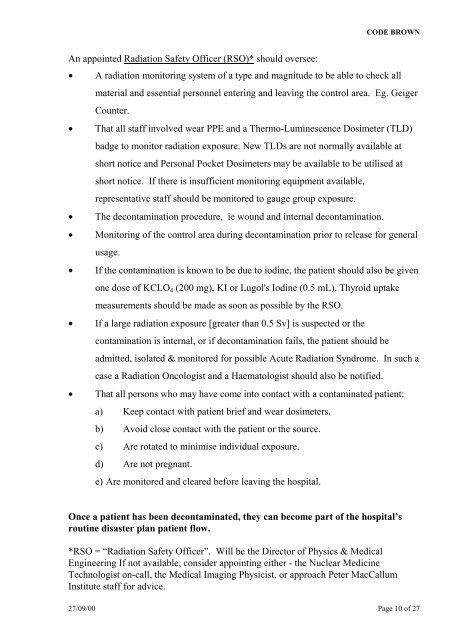EMERGENCY PROCEDURES MANUAL - Department of Health
EMERGENCY PROCEDURES MANUAL - Department of Health
EMERGENCY PROCEDURES MANUAL - Department of Health
You also want an ePaper? Increase the reach of your titles
YUMPU automatically turns print PDFs into web optimized ePapers that Google loves.
CODE BROWN<br />
An appointed Radiation Safety Officer (RSO)* should oversee:<br />
• A radiation monitoring system <strong>of</strong> a type and magnitude to be able to check all<br />
material and essential personnel entering and leaving the control area. Eg. Geiger<br />
Counter.<br />
• That all staff involved wear PPE and a Thermo-Luminescence Dosimeter (TLD)<br />
badge to monitor radiation exposure. New TLDs are not normally available at<br />
short notice and Personal Pocket Dosimeters may be available to be utilised at<br />
short notice. If there is insufficient monitoring equipment available,<br />
representative staff should be monitored to gauge group exposure.<br />
• The decontamination procedure, ie wound and internal decontamination.<br />
• Monitoring <strong>of</strong> the control area during decontamination prior to release for general<br />
usage.<br />
• If the contamination is known to be due to iodine, the patient should also be given<br />
one dose <strong>of</strong> KCLO 4 (200 mg), KI or Lugol's Iodine (0.5 mL). Thyroid uptake<br />
measurements should be made as soon as possible by the RSO.<br />
• If a large radiation exposure [greater than 0.5 Sv] is suspected or the<br />
contamination is internal, or if decontamination fails, the patient should be<br />
admitted, isolated & monitored for possible Acute Radiation Syndrome. In such a<br />
case a Radiation Oncologist and a Haematologist should also be notified.<br />
• That all persons who may have come into contact with a contaminated patient:<br />
a) Keep contact with patient brief and wear dosimeters.<br />
b) Avoid close contact with the patient or the source.<br />
c) Are rotated to minimise individual exposure.<br />
d) Are not pregnant.<br />
e) Are monitored and cleared before leaving the hospital.<br />
Once a patient has been decontaminated, they can become part <strong>of</strong> the hospital’s<br />
routine disaster plan patient flow.<br />
*RSO = “Radiation Safety Officer”. Will be the Director <strong>of</strong> Physics & Medical<br />
Engineering If not available, consider appointing either - the Nuclear Medicine<br />
Technologist on-call, the Medical Imaging Physicist, or approach Peter MacCallum<br />
Institute staff for advice.<br />
27/09/00 Page 10 <strong>of</strong> 27

















